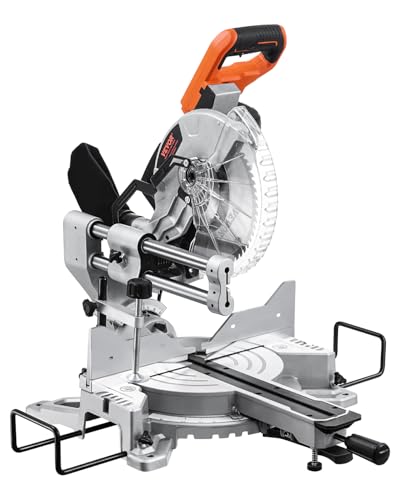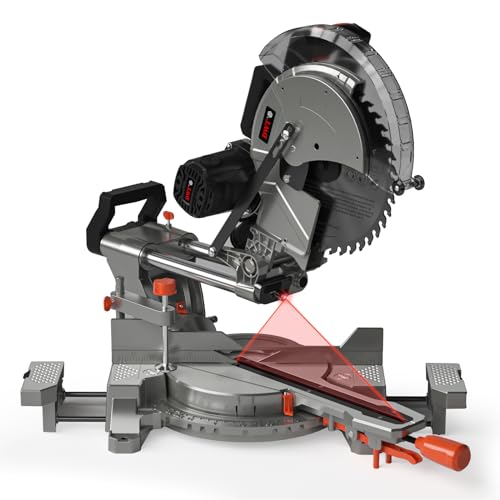When it comes to woodworking or home improvement, precision matters. That’s why choosing the best mitre saws can transform the way you cut angles, trim, and join pieces. But here’s the catch—there are dozens of models out there, and not all deliver the same results.
So, what should you look for? Think of how certain tools, like the best saw blade for cutting composite decking, are tailored to specific tasks. The same principle applies to mitre saws. If you’re exploring versatile options, comparing the best japanese woodworking saws can give you a sense of craftsmanship and quality that sets top-tier tools apart. And let’s not forget—the market is full of choices, making it important to know which ones truly rank among the best saws.
Stick with me, because in this review, you’ll find clear answers, detailed comparisons, and practical advice to guide your purchase.
Top Picks
Best Sliding Precision: DEWALT Miter Saw, 12 Inch Double Bevel Sliding Compound Miter Saw
The DEWALT DWS779 is a 12-inch sliding miter saw built for accuracy and strength. It runs on a corded electric power source with a brushless motor delivering 3800 RPM. The carbide blade has 32 teeth, providing clean and precise cuts at angles up to 45 degrees. The saw includes essential components such as a blade wrench, user guide, and a carbide blade, all designed to make setup and operation straightforward. Its sturdy metal frame and brushed finish contribute to long-term durability, while the 3-year limited warranty offers extra assurance.
Professionals often highlight the DWS779’s cutting power and smooth performance, making it a trusted tool for woodworking and construction projects. Many users appreciate its accuracy and consistency on demanding tasks. However, some point out its 56-pound weight as a drawback for those needing frequent transport.
The DEWALT DWS779 delivers excellent performance and reliability at its price point. While not the most portable, it excels in precision, durability, and power, making it a strong investment for both professionals and dedicated hobbyists.
Best Portable Miter: DEWALT 20V MAX 7-1/4-Inch Miter Saw
The DEWALT DCS361B is a battery-powered miter saw designed for mobility and ease of use. Running on a 20-volt lithium-ion system, it reaches speeds up to 4500 RPM for fast and accurate cuts. The 4-inch, 80-tooth carbide blade handles both wood and metal with precision. It comes with practical accessories including a blade wrench, carbide blade, material clamp, and user guide. With bevel functionality and a spindle lock, this model is engineered for versatile cutting tasks while maintaining a compact, lightweight form factor at just 30 pounds.
Users frequently note the convenience of its cordless design, especially for jobs where outlets are limited. Its lightweight build makes transport easy without sacrificing accuracy. However, the need to purchase a separate battery is often seen as a drawback, particularly for first-time buyers. The smaller blade also restricts cutting capacity compared to larger models.
The DEWALT DCS361B is a solid choice for those prioritizing portability and convenience over heavy-duty capacity. It provides reliable performance, accurate cuts, and a user-friendly design, making it well-suited for on-site projects and lighter woodworking tasks.
Best Value Bevel: SKIL 10" Dual Bevel Sliding Compound Miter Saw-MS6305-00
The SKIL MS6305-00 is a 10-inch corded electric miter saw engineered for precise and versatile cuts. Operating at 4800 RPM with a 15-amp motor, it provides strong cutting power across wood and stainless steel surfaces. The saw includes essential accessories such as extension rods, a dust bag, clamp, and hex key, enhancing its usability out of the box. With a 40-tooth high-speed steel blade and bevel capability up to 50 degrees, it allows flexibility for angled and compound cuts. The 39.4-pound build adds stability during operation while a brushed finish ensures durability.
Professionals and DIY users often appreciate the balance between affordability and performance with this SKIL model. The wide cutting angle and high speed make it versatile for different tasks. Some users, however, find the weight a limitation for frequent transport, and the plastic handle may not feel as robust as metal alternatives.
The SKIL MS6305-00 offers reliable cutting power and useful features at a competitive price. It is best suited for users seeking a dependable miter saw for regular workshop projects, combining solid performance with good overall value.
FAQs
What saw is best for cutting mitres?
A dedicated mitre saw is the best tool for cutting mitres because it is designed to handle precise angle cuts. Sliding compound mitre saws offer the most versatility, allowing you to cut wider boards with both bevel and mitre adjustments. For smaller projects or trim work, a standard compound mitre saw often provides enough accuracy. The choice depends on the type of material you plan to cut and the frequency of use.
Which brand of saw is the best?
Brands like DeWalt, Makita, Bosch, and Metabo HPT are consistently ranked among the best for mitre saws. DeWalt is known for durable builds and user-friendly designs, while Makita often emphasizes smooth operation and innovation. Bosch stands out with precise engineering, and Metabo HPT balances quality with affordability. Ultimately, the best brand is the one that offers the features you need, fits your budget, and provides reliable long-term performance.
What is the best quality miter saw stand?
A high-quality miter saw stand should be stable, portable, and easy to set up. The DeWalt DWX726 rolling stand is a popular option because of its robust construction and convenient mobility. Bosch’s T4B Gravity-Rise stand is another favorite, offering excellent stability with fast setup. Look for stands that can handle heavy loads, have extendable arms for long boards, and include quick-release brackets for mounting your saw.
Is it better to have more or less teeth on a mitre saw blade?
The number of teeth on a mitre saw blade affects the cut quality. Blades with more teeth (such as 80-tooth blades) produce smoother, cleaner cuts, making them ideal for fine woodworking and trim. Fewer teeth (like 24-tooth blades) cut faster and are better for rough carpentry or framing where speed matters more than finish. Choosing the right blade depends on whether you prioritize speed or precision in your work.
How do I choose a miter saw?
When choosing a mitre saw, consider the following factors:
-
Type of saw: Decide between a standard compound mitre saw or a sliding compound model for more capacity.
-
Blade size: Larger blades, such as 12 inches, can cut wider and thicker material, while 10-inch blades are easier to control and more affordable.
-
Cutting capacity: Ensure the saw can handle the size of boards you work with most often.
-
Features: Look for laser guides, dust collection, and easy angle adjustments.
-
Budget and durability: Balance features with price, but prioritize build quality if you plan to use it frequently.
Conclusion
Selecting the best mitre saws comes down to understanding your project needs, comparing features, and choosing a model that balances power, precision, and durability. With reliable brands offering both entry-level and advanced options, you can find a saw that fits your skill level and budget. Whether you need smooth trim cuts or heavy-duty framing work, the right mitre saw will make every project faster and more accurate.





















